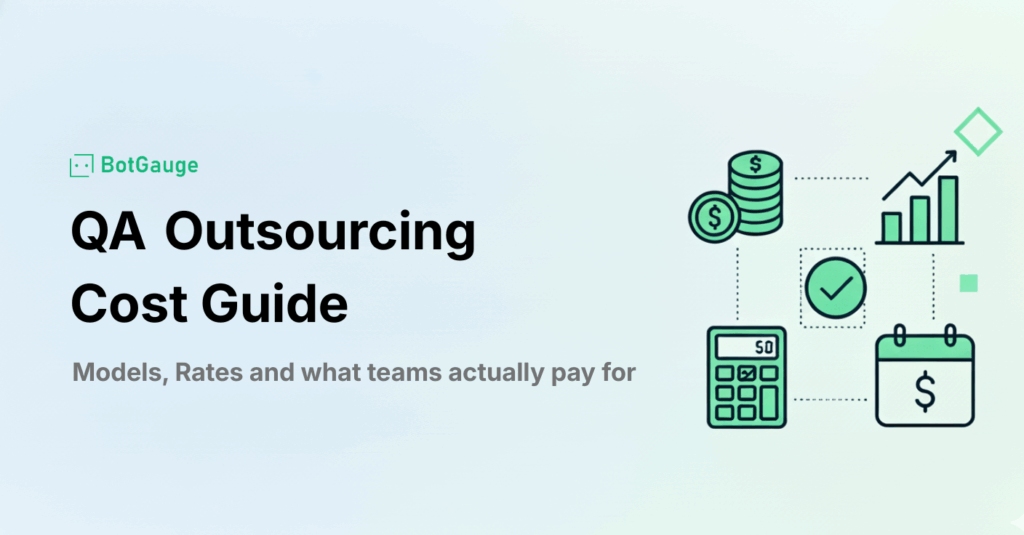Anyone can automate end-to-end tests!
Our AI Test Agent enables anyone who can read and write English to become an automation engineer in less than an hour.
Table Of Content

Table Of Content
In 2025, software teams face a new reality: product releases are getting faster, budgets are tightening, and QA expectations are rising. Outsourcing QA has become one of the most practical ways to control costs while maintaining predictable delivery quality. With the global outsourced testing market now crossing $36 billion and growing at 10.8% CAGR, companies are shifting from old-school staffing models to outcome-driven, pay-for-results QA.
This guide breaks down the real cost of QA outsourcing in 2025, the pricing models that matter, regional rate differences, hidden cost drivers, and when manual vs. automated QA makes the most sense.
In 2025, QA outsourcing costs typically fall into these ranges:
QA outsourcing still revolves around four core pricing models. What changed in 2025 is how companies choose them most teams now prefer predictable outcomes instead of raw staffing hours.
Teams choose T&M when requirements shift frequently, especially in startups or evolving SaaS products.
Great for teams that have well-defined test cases or a stable product backlog.
Usually chosen by mid-sized companies with mature CI/CD pipelines.
Increasingly popular for companies using DevOps-style rapid releases.
| Model | Cost | Best For | Pros | Cons |
| T&M | $15–150/hr | Evolving products | Scalable, flexible | Harder to predict spend |
| Fixed | $3K–50K | Defined scope | Predictable budget | Rigid for changes |
| Dedicated | $4K–15K/mo | Long-term QA | Full integration | Monthly lock-in |
| Hybrid | Mixed | DevOps & global teams | Balanced | Overhead cost |
Global QA rates vary heavily by location due to seniority, demand, and automation skill availability.
| Region | Junior QA ($/hr) | Senior QA ($/hr) | Notes | Savings vs. In-House |
| Asia-Pacific | 20–30 | 35–50 | Strong cost efficiency | 60–70% |
| Eastern Europe | 25–40 | 45–60 | Strong automation skills | 40–60% |
| LATAM | 25–35 | 40–55 | Great time-zone overlap | 30–50% |
| North America | 60–80 | 100–120 | Highest rates | 0% |
Real-world QA outsourcing cost is shaped by:
These hidden drivers are where teams often overspend.
For a typical mid-scale application (100–200 test cases), here’s the real 2025 cost breakdown:
| Approach | Timeline | Monthly Cost | Total Cost(70% Coverage) |
| Manual In-House | 4 months | $5K | $20K |
| Low-Code Tools | 4 months | $3K | $12K |
| Outcome-Based QA (e.g., BotGauge-style) | 2–4 weeks | $2K | $2K |
| Traditional QA Agencies | 4 weeks | $6K | $6K |
Outcome-driven models consistently deliver the lowest cost and fastest timeline for startups.
Even with AI and automation gaining adoption, manual QA remains essential in multiple scenarios:
Manual testers uncover 20–25% more UX issues that automation misses in early features.
Humans detect navigation friction, readability problems, and flows that feel “off.”
HIPAA, GDPR, and SOC2 audits often rely on human review for sensitive flows.
When product specs change 30–40% mid-cycle, manual QA adapts instantly without re-writing automation.
Companies often overpay because they miss these critical warning signs:
A short pilot project (usually $1,000–$5,000) is a reliable way to validate a vendor.
A fintech company outsourced 150 test cases to a senior QA team in Eastern Europe under a T&M model.
A comparable outcome-driven model priced at $2,000/month achieved similar coverage in 2–4 weeks, showing how modern QA outsourcing reduces cost dramatically compared to standard staffing models. This guide extensively covers on all the factors you should consider while choosing an QA Outsourcing partner.
These trends strongly influence both pricing and delivery in 2025:
SLA-driven agreements becoming mandatory for enterprise compliance.
QA outsourcing in 2025 is no longer just a way to cut costs, it’s one of the most reliable methods to speed up releases, stabilize quality, and free internal teams to focus on product development. With predictable pricing models, access to global talent, and outcome-based options like BotGauge costing as low as $2,000/month, outsourcing provides 30–70% savings compared to in-house QA.
By choosing the right pricing model, understanding regional rates, and avoiding common pitfalls, companies can turn QA from a cost burden into a strategic advantage.
Use a T&M model and estimate cost based on hourly rates ($20–60/hr globally), with a buffer of 20–25% for shifting requirements.
Outcome-driven or pay-per-test cases models like BotGauge (~$2K/mo) are the most cost-efficient and efficient.
Expect ~20% higher cost due to data validation, model behavior checks, and specialized testing workflows.
Yes. Outsourcing manual-only QA reduces cost by 40–50% compared to full-cycle outsourcing.
Eastern Europe offers the best balance—strong automation expertise at mid-range pricing.
Add 10–15% overhead for compliance, documentation, and secure environment requirements.
Approximately $6,000–12,000/month depending on team size and automation depth.
Outsourcing reduces release time by 20–40% if SLAs and communication channels are well-structured.
Rework caused by unclear requirements—typically 15–25% of project cost.
Use fixed-price for stable modules and monthly/outcome-driven QA for evolving features; hybrid is the optimal setup.
Share
Curious and love research-backed takes on Culture? This newsletter's for you.
View all Blogs
Our AI Test Agent enables anyone who can read and write English to become an automation engineer in less than an hour.